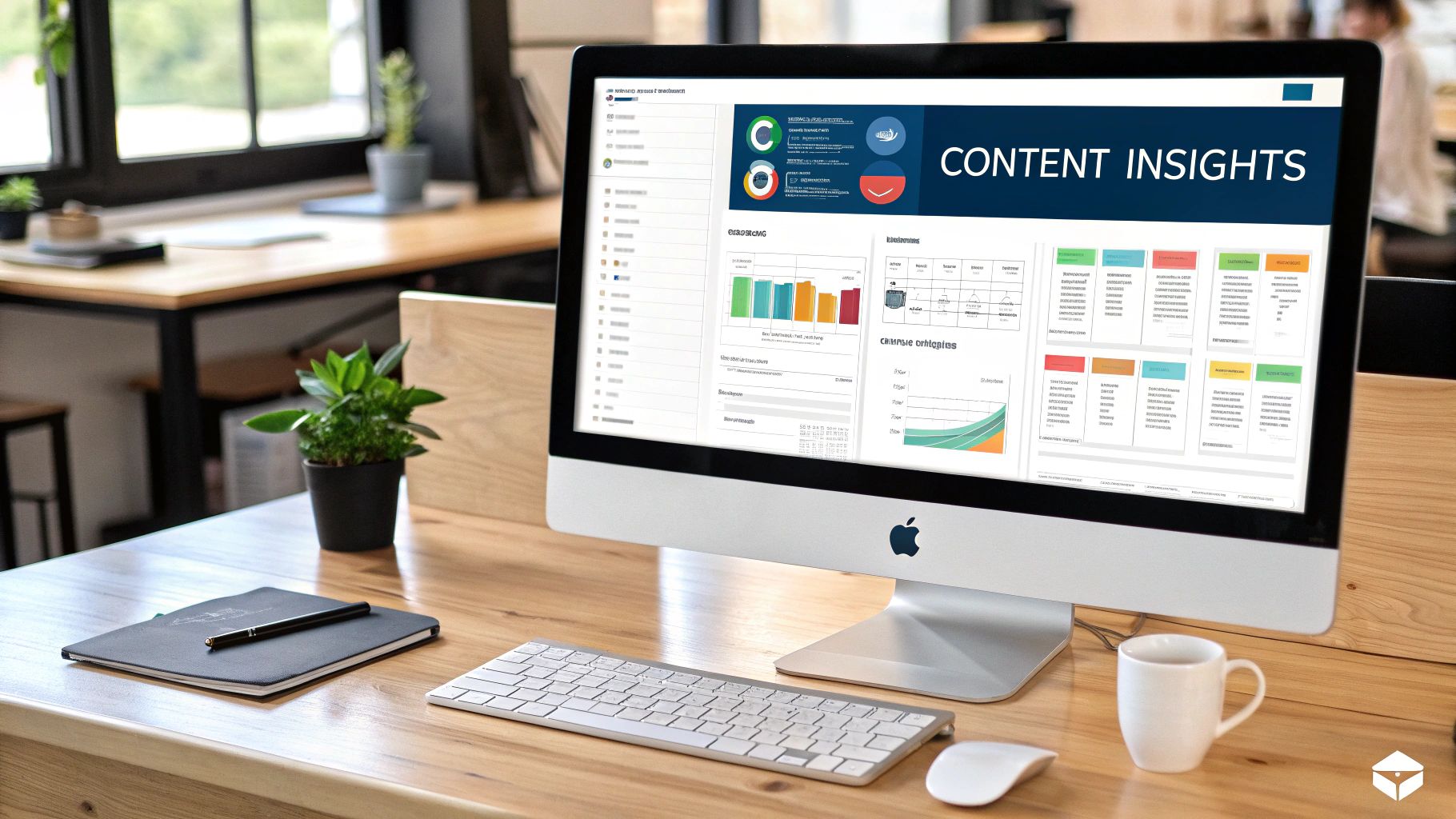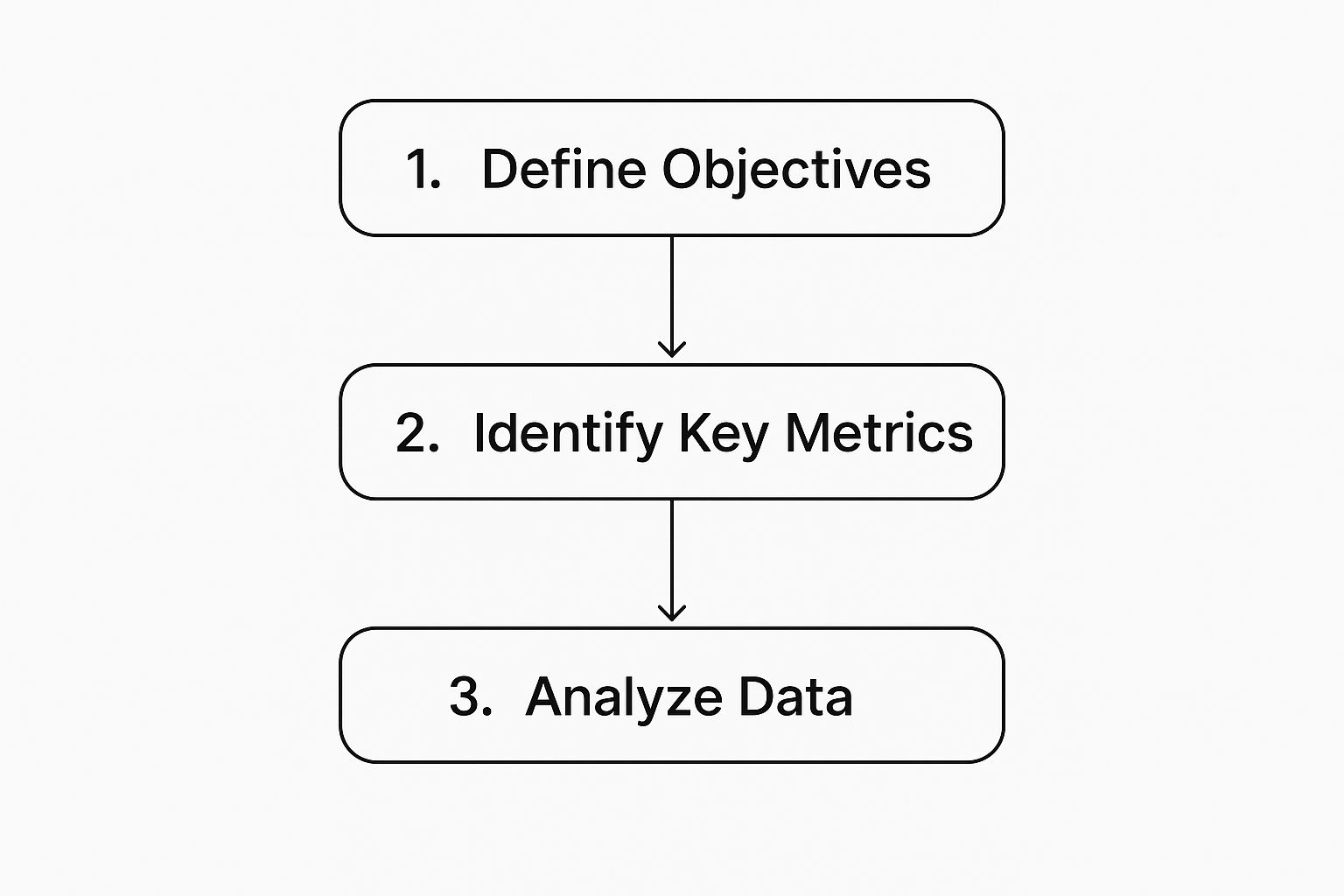It’s time to stop guessing what works and start knowing. Content performance analysis is your roadmap to understanding how every blog post, video, and social update truly impacts your business goals. It's the process of drawing a clear line from your content to tangible outcomes like leads, sales, and customer loyalty.
What Is Content Performance Analysis Really About?

A lot of marketers get stuck tracking vanity metrics like page views or social media likes. And while those numbers can feel good, they don't tell you the whole story. Real content performance analysis digs much deeper. It forces you to ask the tough questions about where your content fits into the customer journey.
This means shifting your mindset from a content production treadmill—just creating more—to a focused strategy of creating the right content that has a clear, measurable purpose.
Think of it like this: publishing content without analyzing its performance is like setting sail without a compass. Sure, you're moving, but are you getting any closer to your destination? A systematic approach to analysis is that compass. It turns a sea of raw data into a genuine strategic asset.
Why a Systematic Approach Is Essential
Wingin' it with your content analysis is a recipe for disaster. You risk falling into common traps, like pouring your budget into content that racks up views but never converts, or worse, killing a campaign that was quietly nurturing your most valuable leads.
A structured process helps you avoid those pitfalls and instead:
- Justify Marketing Spend: Clearly connect your content efforts to revenue and prove ROI to stakeholders.
- Optimize Your Strategy: Pinpoint exactly what resonates with your audience so you know where to double down.
- Discover Content Gaps: Uncover the topics and formats your competitors are ignoring and create valuable resources to fill those needs.
This kind of strategic focus is non-negotiable. With 82% of companies now relying on content marketing, the competition is fierce. The good news? 76% of marketers report that their efforts directly generate leads, proving its powerful impact on the sales pipeline. For a deeper dive, you can explore more content marketing statistics to understand the competitive field.
The goal of content performance analysis isn't just to report on what happened last quarter. It’s to build an intelligent feedback loop that informs every single content decision you make from now on.
By making analysis a core, non-negotiable part of your workflow, you can finally move from making reactive adjustments to building a proactive strategy. This guide will give you the framework to do just that, helping you turn your content into a predictable engine for growth.
Building Your Analysis Framework
You can't measure what you haven't defined. A truly effective content performance analysis doesn't start with you drowning in spreadsheets. It begins with a solid, intentional framework that connects every piece of content you create directly to your business goals.
Without this structure, you're just chasing vanity metrics. With it, you're gathering real business intelligence. The first move is always to define what success actually looks like for your team.
Your goals need to be sharp and measurable. "Increase brand awareness" is too fuzzy. A much better, more actionable objective is something like, "Increase organic traffic to our blog by 20% in Q3 to grow our email subscriber list." This clearly ties a content metric (traffic) to a concrete business outcome (subscriber growth).
This whole process—from high-level goals down to the nitty-gritty data—can be visualized like this:

As you can see, figuring out your objectives and KPIs before you ever open an analytics tool is what keeps your efforts focused and strategic.
Selecting the Right KPIs
Once you know what you're trying to achieve, you can pick the Key Performance Indicators (KPIs) that will actually tell you if you're getting there. The right KPIs are completely dependent on your content's specific job. A one-size-fits-all approach just doesn't cut it.
Let’s look at a few real-world scenarios:
-
For a Top-of-Funnel Blog Post: The main goal here is to attract new eyeballs. You'll want to watch metrics like Organic Impressions, Page Views, and Average Time on Page. A high bounce rate might not be a red flag if the time on page is solid—it could just mean the reader found their answer and left satisfied.
-
For a Mid-Funnel Webinar: This is all about lead generation. The KPIs that matter are Registration Rate, Attendance Rate, and the number of New Contacts generated from the event.
-
For a Bottom-of-Funnel Case Study: Here, the finish line is conversion. The most critical KPIs are Demo Requests, Free Trial Sign-ups, or Downloads originating from that page.
A classic mistake I see all the time is tracking the exact same metrics for every single piece of content. The real magic happens when you tailor your KPIs to what that specific blog post, case study, or video is designed to do. That’s what separates shallow reporting from deep, actionable insight.
Configuring Your Tools for Clean Data
Your analysis is only as reliable as the data you're pulling. That's why getting your tools set up correctly from day one is non-negotiable. If your platforms aren't configured to capture the right events and talk to each other, you're flying blind.
Start with your core analytics platform, like Google Analytics. You need to configure goals that mirror your KPIs. This means tracking things like form submissions for a newsletter, clicks on a "Request a Demo" button, or views of a critical page in the buyer's journey.
This is the kind of high-level view you’ll get from a standard Google Analytics dashboard.

An overview like this is your first stop for spotting trends in traffic sources and user engagement, giving you the initial clues for where to dig deeper.
But don't stop at website analytics. You absolutely need to connect your CRM and social media dashboards. Integrating a CRM like HubSpot or Salesforce lets you see which content isn't just generating leads, but generating qualified leads that turn into customers. This is how you finally close the loop and prove content ROI. Similarly, make sure your social tools are tracking clicks and conversions, not just likes and shares.
Choosing Metrics That Tell the Full Story

It’s easy to get lost in a sea of data. I’ve seen countless teams jump into content performance analysis by tracking every metric under the sun, only to get overwhelmed. The biggest pitfall is obsessing over vanity numbers like total page views, which often sends you chasing the wrong goals entirely.
Real insight comes from picking KPIs that actually tell the story of how your content is impacting your business. This means your dashboard should be a direct reflection of your goals. The metrics that matter for a SaaS company rolling out a new feature will look nothing like those for an e-commerce brand pushing a seasonal sale. The trick is to tie every metric you track back to a specific business objective.
Beyond Page Views to Business Impact
To really understand performance, I like to categorize metrics based on the user's journey. This helps move the conversation from simple awareness to tangible, bottom-line results. Each category should answer a different question about how your audience interacts with your content.
I recommend starting with three core groups:
- Engagement Signals: These tell you if people actually care about what you’ve published. Forget simple likes and shares. I’m talking about average time on page, scroll depth, and the quality of comments. Are people just skimming, or are they truly reading and interacting?
- Conversion Actions: This is where your content starts making you money. You need to track specific, meaningful actions like free trial sign-ups, demo requests, or e-book downloads.
- Audience Loyalty: Are you building a dedicated community or just attracting fly-by visitors? Metrics like return visitor rate, newsletter subscriber growth, and a properly contextualized bounce rate reveal whether you’re creating lasting relationships.
When you blend these metrics, a much clearer picture emerges. For example, a blog post might have modest page views but an incredibly high conversion rate for newsletter sign-ups. That makes it a quiet powerhouse for building your audience, something you’d miss if you only looked at traffic.
Aligning Metrics with Content Goals
Once you have your core metrics, the next move is to assign them to individual content pieces based on their specific purpose. This is all about judging each asset fairly and based on what it was designed to do.
Think about it this way: a top-of-funnel "how-to" guide for a software company should be measured on its ability to pull in organic search traffic and capture email subscribers. A bottom-of-funnel product comparison post, on the other hand, should be judged almost entirely on its power to drive add-to-cart actions or demo requests. They have different jobs, so they need different scorecards.
The most effective analysis connects content directly to revenue. When choosing metrics that truly reflect your content's impact, understanding different marketing attribution models is crucial for properly crediting conversions and proving ROI.
The data backs this up. In a world saturated with content, brands that create messages that genuinely connect with their audience see much deeper engagement, which is what builds trust and drives sales. True success isn’t about being the loudest; it’s about being the most resonant. For a deeper dive, Sproutsocial's benchmark report offers great insights into how engagement shapes overall performance.
Ultimately, your goal is to build a measurement framework that’s as unique as your strategy. By looking past the generic numbers and focusing on what truly drives your business forward, you can turn content performance analysis into a genuine engine for growth. To get started, you can even lean on various website audit tools to improve performance to help gather the right data.
Using AI for Smarter Content Analysis
Let's be honest: manually pulling data and wrestling with spreadsheets is a soul-crushing part of the job. It's time-consuming, and frankly, it's becoming obsolete. The real breakthrough in content performance analysis is happening with artificial intelligence, which handles the grunt work and, more importantly, uncovers insights that are simply impossible to find on your own.
AI doesn't just tell you what happened; it helps you figure out why and what to do next. This is a huge shift. Instead of reacting to last month's numbers, you can start building a proactive, predictive strategy. It’s no surprise that enhancing digital marketing with AI has become a major focus for teams looking to get ahead.
The numbers back this up. It's expected that 90% of content marketers will start using AI in their workflows this year. Why the rush? Because it works. Marketers who have already adopted AI are far less likely to feel their content strategy is falling short. We're already seeing it used widely for tasks like brainstorming and outlining, which gets the creative process off to a much faster start.
Automating Insights and Predicting What's Next
This is where AI really shines. It connects dots across different data sources to find patterns you’d never spot otherwise. This is so much more than just tracking page views.
Here are a few ways this plays out in the real world:
- Sentiment Analysis: Imagine instantly knowing how people feel about your latest campaign. AI can sift through thousands of social media comments and reviews to gauge public sentiment—positive, negative, or just plain neutral. That's invaluable feedback for tweaking your message.
- Topic and Gap Identification: Instead of guessing what to write about, AI tools can analyze your competitors and the wider web to find trending topics and content gaps in your niche. You can get ahead of the curve before a topic becomes completely saturated.
- Predictive Analytics: This feels like the future, but it's here now. Some AI platforms can look at your past performance to predict which headlines, formats, or topics will click with certain parts of your audience. It takes a lot of the guesswork out of planning.
Think of AI as your 24/7 data scientist. It never sleeps, never gets bored, and it’s brilliant at finding those subtle connections—like the link between a blog post's scroll depth and a new customer's lifetime value.
Practical AI Tools You Can Use Today
You don't need a massive budget or a team of data scientists to get started. Plenty of user-friendly tools can give you a boost right away. Look into content optimization tools that score your drafts against top-ranking articles or platforms that can audit your entire content library and flag old posts that are perfect for a refresh.
By bringing these tools into your process, you can work faster, make more informed decisions, and get a serious competitive advantage. This kind of data-driven approach is what separates good marketing from great marketing. If you're building your strategy from the ground up, our beginner's guide to digital marketing can help you lay a solid, data-informed foundation.
Turning Your Data Into an Actionable Strategy
Collecting data is one thing; knowing what to do with it is another game entirely. The real work in content performance analysis starts when you translate those spreadsheets and dashboards into a tangible, results-focused plan. This is the moment your analysis stops being a look in the rearview mirror and starts being the GPS for your content calendar.
Your findings should be a direct signal for your next move. If a certain topic cluster consistently brings in high-quality leads, the path forward is clear: double down and create more content around that theme. Or maybe you notice your two video posts got 5x more engagement than anything else. That’s not a fluke; it's a sign to invest more resources into video. You're building a feedback loop where data constantly sharpens what you create.
Conducting a Practical Content Audit
One of the best ways to put your data to work is with a targeted content audit. This isn't about getting lost in the weeds and reviewing every single post you've ever published. It’s a focused mission to sort your existing content into specific buckets based on how it’s actually performing.
This process helps you make three critical decisions: what to promote, what to update, and what to prune. Think of it as spring cleaning for your content library—you want to make sure every single asset is pulling its weight.
I see so many teams treat all their content as equal. That's a huge mistake. A good audit forces you to be ruthless. You'll almost certainly find that a small fraction of your content drives the vast majority of your results. Your job is to find those winners and give them the attention they deserve.
Start by pulling your key metrics for each piece of content. You’re hunting for patterns that will help you classify every asset.
Classifying Your Content for Action
As you review the performance of each post, drop it into one of these categories. This simple framework gives you an immediate, actionable next step for everything you’ve created.
-
High Performers (Keep & Promote): These are your all-stars. They rank well for important keywords, pull in steady traffic, and turn visitors into leads or customers. The mission here is to amplify them. Link to them from new articles, feature them in your newsletter, and use them as the cornerstone for new, related content.
-
Underperformers (Update & Relaunch): These are the posts with untapped potential. Maybe they target a great keyword but are stuck on the second page of Google. Or maybe they get decent traffic but the conversion rate is terrible. The strategy here is a content refresh. Update the stats, add fresh visuals, sharpen the call-to-action, and then relaunch it like it's brand new.
-
Low Performers (Remove or Redirect): This is the content that’s just sitting there, gathering dust. It gets virtually no traffic and serves no real strategic purpose. These posts can even hurt your SEO by creating "content bloat." The best move is often to just delete them and let them 404. If they happen to have a few valuable backlinks, 301 redirect them to a more relevant, high-performing page instead.
-
Content Gaps (Create & Conquer): Finally, your audit will reveal what's missing. By looking at what’s working for you and what your competitors are ranking for, you’ll spot golden opportunities they’ve missed. This is where you'll find the ideas for your next wave of killer content.
This kind of structured audit turns a pile of raw data into a clear roadmap. To take this even further, check out these excellent content marketing hacks to grow your blog that you can apply to your high-performing assets. By systematically finding your winners, fixing what's broken, and filling the gaps, you ensure your content strategy is always firing on all cylinders.
Answering Your Top Analysis Questions

Putting a content performance analysis strategy into practice always surfaces a few key questions. Let's walk through some of the most common ones I hear from marketers. Getting clear on the details, from timing to tools, is what separates a report that sits on a shelf from one that actually drives decisions.
One of the first questions is almost always, "How often should I really be doing this?" Honestly, it depends on your content pace and what you’re trying to achieve. A monthly review is a solid baseline for most teams—it’s frequent enough to spot meaningful trends without getting lost in the daily noise.
But if you're in the middle of a major campaign or a new product launch, you’ll want to check in far more often. Think weekly, or even daily. This lets you make quick, data-backed pivots instead of waiting a month to find out something wasn't working.
What About Tools and Attribution for Smaller Teams?
If you're a solo marketer or part of a small team, the thought of adding another expensive tool to your stack can be daunting. The good news is you don't need a massive enterprise suite to get started.
You can get incredibly far with a combination of Google Analytics (for website behavior) and the native analytics on your social media platforms. It's a powerful—and free—place to begin. The goal is to find tools that give you actionable data, not just more data.
Focus on platforms that clearly show you metrics like:
- Entrances: How many times was this page the first one a visitor saw? This tells you how well it attracts new people.
- Time Per Page View: The average time people are actually engaged with your content.
- Total Form Submissions: The hard number of leads your content directly produced.
Attribution is another big one. It's tough trying to prove that a blog post someone read three weeks ago led to today's sale. My advice? Start simple. Use a "first-touch" model that gives credit to the very first piece of content a person interacted with. You can always get more sophisticated later, but don't let the quest for a perfect attribution model stop you from getting started.
How Do I Present My Findings to Leadership?
So you’ve gathered all this great data. Now what? How do you show your boss or leadership team that your work is paying off? The key is to ditch the giant, overwhelming spreadsheets and build a simple, visual dashboard that tells a compelling story.
You have to connect your content metrics to real business outcomes. Don't just report that a blog post got 10,000 views. Instead, frame it in a way that resonates with them.
Try this: "This blog post generated 50 new leads. Historically, leads from our blog convert at 10%, which translates to a potential pipeline value of X." When you speak the language of revenue, growth, and customer acquisition, you instantly shift the perception of content from a cost center to a critical business driver.
Ready to stop guessing and start growing? EvergreenFeed automates your social media scheduling with your best-performing evergreen content, ensuring your top posts get the visibility they deserve without the manual effort. Start saving time and boosting your reach today. Learn more and sign up for free at EvergreenFeed.




